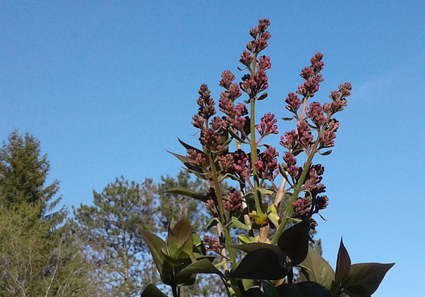 Photo by C. Carle 2018 Photo by C. Carle 2018 We've been a bit negligent in posting material for the past few months, but spring is here; and with it a sense of renewal and purpose. Originally posted in May of 1987, I hope you enjoy this story as much as I did. We are in that "in‑between" season right now when it is too early to do much to the garden but the seed orders are in and there is really no reason to go through the catalogues another time, although I got a seed catalogue from a company down in South Carolina a few weeks back that has me thinking disloyal thoughts about our puritanical climate. My wife, more given to action than to words, seized a garden fork and a rake the other weekend and produced a raised bed within minutes. It was obviously the work of one who was tired of waiting for 40 growing degree days (GDD) to arrive with some sort of regularity. If I remember the drill correctly (I forget it after the growing season is over in the Fall and always have to go look it up in the Spring but at the moment I can't find the book that purveys the needed wisdom), you take the high and low for the day, subtract 40 from each and the result is the number of growing‑degree days to base 40. Yesterday's high here was 57 and the low was 29. Plus 17 and minus 11 works out to plus six GDD yesterday. Don't ask me what it was in Celsius. (Alternatively, you could add high and low together and subtract 80 to get the same result. Why didn't I think of that before?)
What that tells us, when we begin to get plus figures consistently, is that the cold‑weather crops like onions and peas and lettuce can go in the ground safely and will make respectable progress no matter what the rest of us think about the fogs and damps. The same process repeated to the base 50 signals time for beans and the warm‑weather crops to be planted. That isn't so hard to figure though, because around here there is the chance of frost into early June, if the full moon falls in the first part of the month. Once we are over that hurdle the ground has warmed up enough to take on whatever you want to try – as long as it will be ready to close up shop in about a hundred days. It is this time of year that sets me thinking about the Loyalists and what they must have felt like in the difficult days of resettlement after arriving on these shores. I was thinking about them particularly during the lovely weather we had in April. It has been 25 years since we came to the True North Strong and Free. We came for positive reasons and have become Canadian citizens because we thought and still think that Canada is a better place than the high‑priced spread below the border, but, oh my, that warm weather in April! What must the Loyalists have thought, resettled as they were not by choice but compelled by necessity, as dank and dreary March dragged on into damp and foggy April and then after a heart‑lifting excursion into Spring for a few minutes toward the end of April everything slumped back into a sullen re‑run of March and even the Spring Peepers, up to their necks in chilly water, stopped telling everyone how marvelous mud is? Did they have the onions in the ground in early April, I wonder, or did some kind indigenous citizen take pity on them and tell them the facts of life just over the hill from the Arctic Circle? So we take refuge in watching for tell‑tale signs in the natural world that will tell us where we really are in the circle of the seasons, GDD being only the most high‑tech indicator. The old lilac bushes at the front porch, bushes that have seen more than two or three meretricious pseudo‑Springs in their day, have leaf buds that have begun to open – but the bush in the door‑yard, farther away from shelter and reflected heat from the house, is not making any large statements, although I notice that leaves on the new shoots are further ahead than those on the old trunk. Youth is more optimistic than age, less inclined to caution, even in the vegetable world, it seems. In some parts of the world it is the leaves on the oaks that must be the size of a mouse's ear before the early crops can go in the ground. Around here I would bet on the lilac leaves I think. They seem to get to be the right size at about the right time for early planting. In any case watching for signs of progress is a lot better than fantasizing about growing seasons that run neck-and-neck with the baseball season. |
Words & ImagesWe moved to our farm in Sussex, New Brunswick from Toronto in 1977, only moving away in 2014. Archives
April 2020
Categories
All
|
